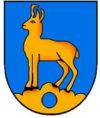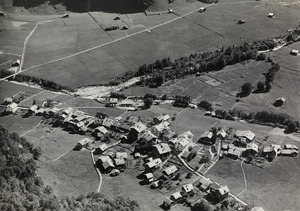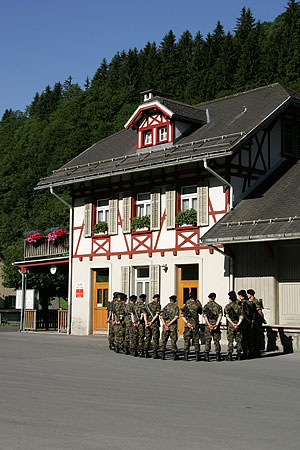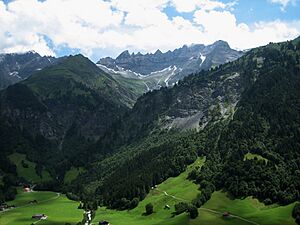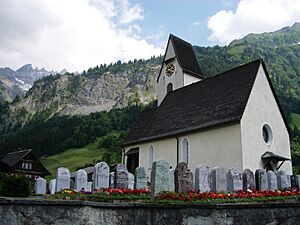Elm, Switzerland facts for kids
Quick facts for kids
Elm
|
||
|---|---|---|
|
Village (and former municipality)
|
||
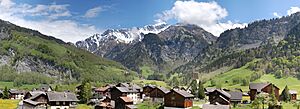 |
||
|
||
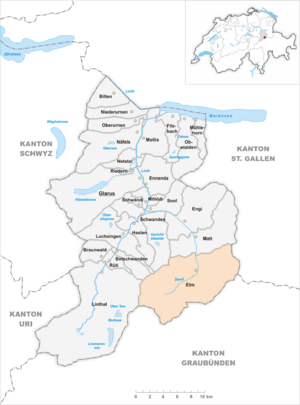
The former municipal area (2007)
|
||
| Country | Switzerland | |
| Canton | Glarus | |
| Municipality | Glarus Süd | |
| Area | ||
| • Total | 90.73 km2 (35.03 sq mi) | |
| Elevation | 977 m (3,205 ft) | |
| Population
(December 2020)
|
||
| • Total | 626 | |
| • Density | 6.900/km2 (17.870/sq mi) | |
Elm is a charming village in Switzerland. It used to be its own municipality, but now it's part of the larger municipality of Glarus Süd. Elm is located in the beautiful valley of the Sernf river. It includes the main village and several smaller areas called hamlets. These hamlets are Sulzbach, Schwändi, Müsli, Untertal, Vogelsang, Töniberg, Obmoos, Steinibach, and Wald.
Contents
History of Elm
Elm was first mentioned in old writings way back in 1344. It was known as Elme then.
Long ago, in the Middle Ages, there were special baths at a place called Wichlen. People believed the water had healing powers. These baths were very popular until a big avalanche covered them in 1762. Many old wooden buildings from that time are still standing today.
In 1799, a famous Russian general named Alexander Suvorov and his soldiers stayed in Elm for a night. They were on their way to cross the Panix Pass into Austria.
In the 1800s, people started digging for slate in Elm. Slate is a type of rock used for roofs and other things. Sadly, on September 11, 1881, too much digging caused a huge avalanche. It killed 114 people and destroyed 83 buildings in the village.
Later, in 1892, a spring in Elm was found to have water rich in iron. People thought it was very healthy. The owner built a bathhouse and sold bottled water. But another avalanche destroyed this bathhouse in 1907. A new health resort, called a Kurhaus, opened in 1898. It was very popular until World War I. Today, it's a retirement home. A company called Mineralquellen Elm AG started bottling the spring water in 1929. They still do this today.
For a long time, Elm was not connected to the main Swiss railway system. This made it harder for the local businesses. So, in 1905, a special electric tramway was built. It connected Elm to the town of Schwanden and other villages. This tramway ran until 1969, when buses took its place.
On January 1, 2011, Elm officially became part of the new municipality of Glarus Süd.
Elm's Location and Nature
Elm is located high up in the mountains, about 977 meters (3,205 feet) above sea level. It sits on the left side of the Sernf river. It's the last village you reach when you go upstream in the Sernf valley. The village of Matt is further down the valley to the north.
Elm is also a starting point for some amazing mountain trails. One trail crosses the Panix Pass into another part of Switzerland called canton of Graubünden. Another trail goes over the Foo Pass to the village of Weisstannen. There's also a trail across the Richetli Pass to the village of Linthal. These trails are part of a long hiking path called the Alpine Pass Route.
Elm is famous for a special natural event involving the "Martin Hole." This is a natural opening in the mountain called Tschingelhörner. Several times a year, in March and September, the sun shines directly through this hole for about a minute. It's like a giant spotlight hitting the area around the church! Many people come to watch this amazing sight.
Part of the mountain cliff called Tschingelhörner is also part of a UNESCO World Heritage Site. This site is called the Swiss Tectonic Arena Sardona. It's a special place where you can see how huge layers of rock have been pushed over each other.
People of Elm
Elm has a population of about 600 people. Most people in Elm speak German. A smaller number of people speak Portuguese or Serbo-Croatian.
Many adults in Elm have completed higher education. This means they have gone to a university or a special college.
The number of people living in Elm has changed over the years. Here's how the population has looked:
| Year | Population |
|---|---|
| 1730 | 516 |
| 1789 | 765 |
| 1850 | 1051 |
| 1900 | 913 |
| 1950 | 867 |
| 1990 | 791 |
Religion in Elm
Elm used to be part of a larger church area in Glarus. In 1493, Elm was allowed to have its own church area, called a parish. In 1528, the Reformation came to Elm. This was a time when many churches changed their practices. In 1594, Elm's church area became completely separate from the one in Matt.
Elm's Economy
For a long time, farming was the main job in Elm. People raised sheep and cattle. In the 1700s, making wool at home also became important. Farmers would take their beef cattle to the Alps in summer and then sell them to Italy.
Today, the main industry in Elm is making mineral water. Since 1929, companies like Mineralquellen Elm AG and now RAMSEIER Suisse AG have bottled water from the local springs. They are famous for their ELMER Citro and ELMER Mineral drinks.
Elm has a very low unemployment rate, which means almost everyone who wants a job has one. Many people work in farming, some in manufacturing, and others in services like tourism or shops.
Getting Around Elm
The Sernftalbus is a bus service that runs every hour. It connects Elm with other villages in the Sernf river valley, all the way to the Schwanden railway station. This bus service replaced the old Sernftal tramway that ran from 1905 to 1969. From Schwanden railway station, you can take a train to Glarus, the capital of the canton.
Fun in Elm: Tourism
Elm is a great place for tourists! A ski resort opened on the Schitzer mountain in 1973. Another area, Pleus, opened for skiing in 1982. So, if you like skiing, Elm is a good spot!
Elm's Climate
Elm has a climate with warm summers. It rains quite a bit throughout the year. On average, Elm gets about 152 days of rain each year. The wettest month is usually August. The driest month is February.
| Climate data for Elm village (1991–2020) | |||||||||||||
|---|---|---|---|---|---|---|---|---|---|---|---|---|---|
| Month | Jan | Feb | Mar | Apr | May | Jun | Jul | Aug | Sep | Oct | Nov | Dec | Year |
| Mean daily maximum °C (°F) | 1.9 (35.4) |
3.0 (37.4) |
7.5 (45.5) |
12.0 (53.6) |
16.4 (61.5) |
19.5 (67.1) |
21.0 (69.8) |
20.4 (68.7) |
16.5 (61.7) |
12.8 (55.0) |
6.6 (43.9) |
2.5 (36.5) |
11.7 (53.1) |
| Daily mean °C (°F) | −1.8 (28.8) |
−1.1 (30.0) |
2.5 (36.5) |
6.7 (44.1) |
10.8 (51.4) |
14.0 (57.2) |
15.6 (60.1) |
15.3 (59.5) |
11.6 (52.9) |
7.9 (46.2) |
2.7 (36.9) |
−0.9 (30.4) |
6.9 (44.4) |
| Mean daily minimum °C (°F) | −5.6 (21.9) |
−5.4 (22.3) |
−1.8 (28.8) |
1.7 (35.1) |
5.8 (42.4) |
9.2 (48.6) |
10.9 (51.6) |
10.9 (51.6) |
7.3 (45.1) |
3.8 (38.8) |
−0.9 (30.4) |
−4.5 (23.9) |
2.6 (36.7) |
| Average precipitation mm (inches) | 103 (4.1) |
90 (3.5) |
114 (4.5) |
105 (4.1) |
140 (5.5) |
163 (6.4) |
184 (7.2) |
194 (7.6) |
142 (5.6) |
116 (4.6) |
120 (4.7) |
117 (4.6) |
1,588 (62.5) |
| Average snowfall cm (inches) | 85 (33) |
86 (34) |
60 (24) |
34 (13) |
3 (1.2) |
0 (0) |
0 (0) |
0 (0) |
0 (0) |
12 (4.7) |
52 (20) |
83 (33) |
415 (163) |
| Average precipitation days (≥ 1.0 mm) | 11.2 | 10.3 | 12.4 | 11.7 | 14.8 | 15.3 | 15.4 | 15.3 | 12.2 | 10.6 | 11.4 | 11.8 | 152.4 |
| Average snowy days (≥ 1.0 cm) | 9.1 | 8.9 | 7.0 | 3.9 | 0.7 | 0.0 | 0.0 | 0.0 | 0.1 | 1.2 | 5.8 | 9.3 | 46.0 |
| Average relative humidity (%) | 75 | 73 | 72 | 69 | 73 | 77 | 79 | 80 | 81 | 78 | 78 | 78 | 76 |
| Source: MeteoSwiss | |||||||||||||
Culture in Elm
In 1981, Elm received the Wakker Prize. This award is given to places in Switzerland that do a great job of protecting and developing their old buildings and cultural heritage.
Famous People from Elm
- Rico Elmer is a Swiss ski mountaineer who was born in Elm.
- Vreni Schneider is a Swiss ski racer. She won Olympic gold medals and world championships in slalom and giant slalom skiing. She was born in Elm in 1964.
See also
 In Spanish: Elm para niños
In Spanish: Elm para niños


